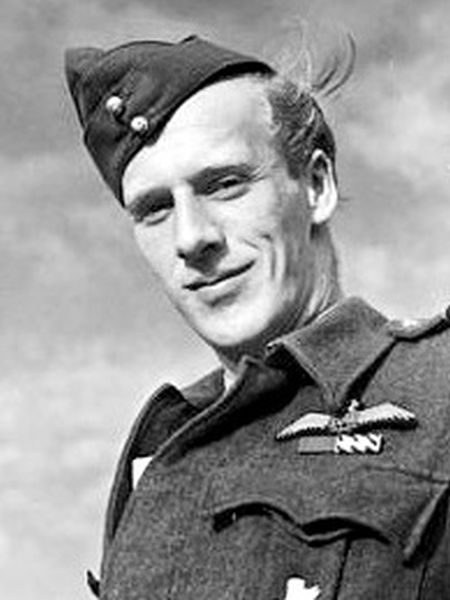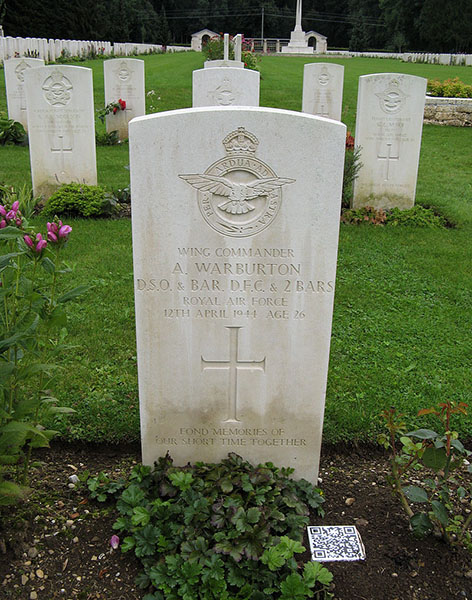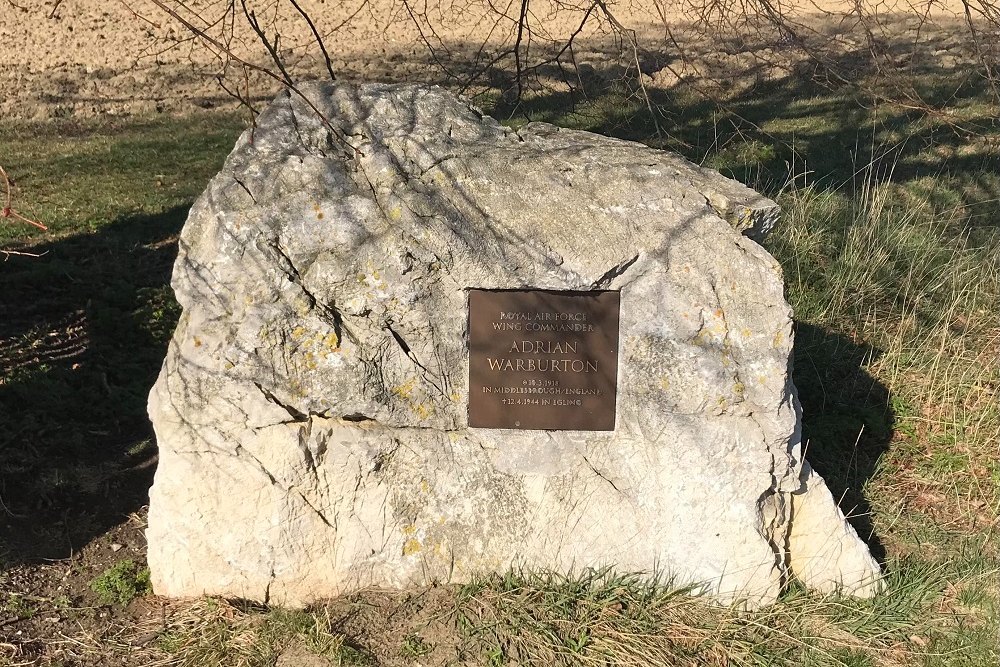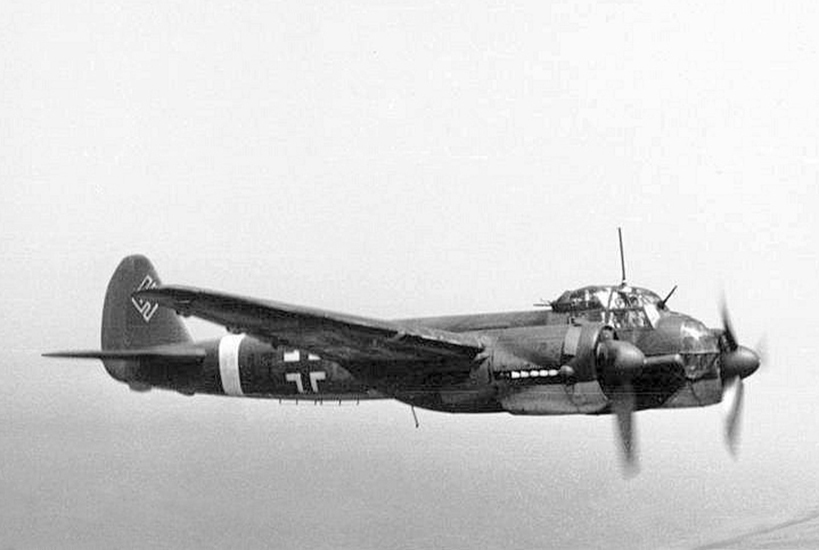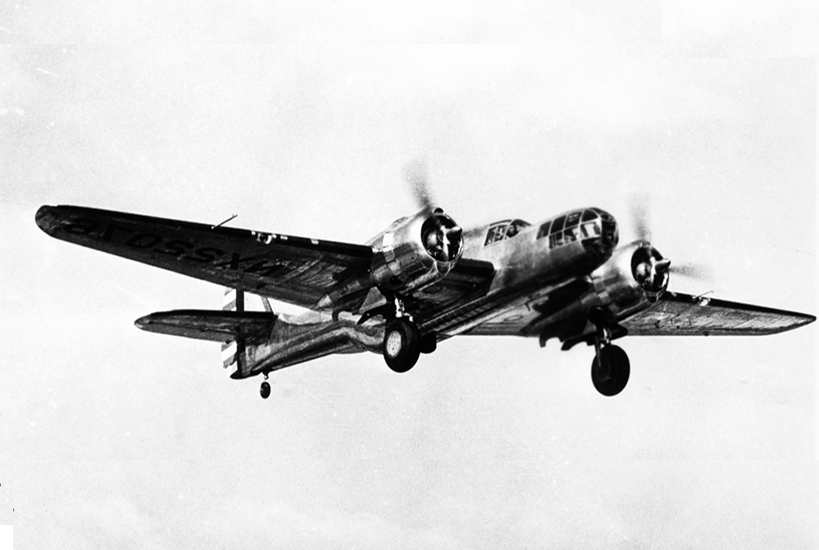Warburton, Adrian "Warby"
- Date of birth:
- March 10th, 1918 (Middlesbrough/ North-Yorkshire, Great Britain)
- Date of death:
- April 12th, 1944 (Egling an der Paar/Bavaria, Germany)
- Buried on:
- Commonwealth War Cemetery Durnbach
- Service number:
- 41635
- Nationality:
- British
Biography
The son of a WW1 submarine captain, Adrian Warburton was christened on board a submarine in Grand Harbour, Valetta, Malta. He attended St Edward's School in Oxford, where two other famous airmen, Guy Gibson and Douglas Bader, were also educated. He became a clerk and joined the Territorial Army as a Private in the Royal Tank Corps.
Warburton joined the RAF on a short service commission in 1939. While on training in Portsmouth, he met Betty Mitchell whom he married.
On completing flying training, he was posted to 608 Squadron, flying Blackburn Botha's on North Sea patrols. Warburton's criticism of the obsolete plane led to his commanding officer having him transferred to Malta as an observer, not a pilot. He joined 431 Flight, an RAF detachment flying reconnaissance sorties over the Mediterranean in twin-engined Martin Maryland recon/light bombers. Within four days of arrival, he had his pilot status reinstated.
"Warby" participated in an increasing number of daring sorties. On 30 October 1940, Warburton and his two crewmen shot down an Italian Z.506B seaplane. Three days later, they nearly fell victim to an attack by four Italian aircraft. Warburton was hit by a spent bullet which caused no serious injury, but did render him unconscious. His observer/navigator, Sergeant Frank Bastard, took control and managed to keep the aircraft flying (for which he received the Distinguished Flying Medal) until Warburton had recovered sufficiently.
During his stay on Malta, Warburton became romantically involved with a cabaret dancer, Christina Rathcliffe, who served later as a civilian plotter in the RAF operations room on Malta.
He was soon back in the air, and on 10 November, 431 Flight spotted a major concentration of Italian battleships and cruisers in Taranto. Admiral Cunningham then deciding on an audacious night attack by Fleet Air Arm Swordfishes. Warburton flew a reconnaissance mission on 11 November prior to the attack, circling the harbour several times, when the cameras failed. Warburton flew so low, his observer was able to read off the names of the battleships as they flew past. Guided by this intelligence, the Fleet Air Arm launched its devastating attack that night. With 431 Flight now expanded into No. 69 Squadron in January 1941, Warburton steadily developed a reputation within the RAF as its leading reconnaissance pilot. In April 1941, he crash-landed in Malta after being mistakenly shot by an RAF Hurricane. Warburton was rested later that year, but returned to operational flying in 1942, with further missions over Italy and North Africa. His second tour finished in mid-March 1942. Given command of 69 Squadron in August 1942 and flying a Supermarine Spitfire, Warburton was shot down by a Bf 109 over Bone in Tunisia, being imprisoned by the French on suspicion of being a spy. The local French admiral had him flown to Gibraltar where "Warby" 'borrowed' a Spitfire and returned to Malta, shooting down a Junkers Ju 88 en route.
He was then involved in the vital pre-invasion reconnaissance of the landing beaches in Sicily in 1943. Now commanding 683 Squadron, he co-ordinated the photographic work with the local American forces, who were impressed by the highly decorated and very experienced RAF-officer.
In October 1943, Warburton was given command of a new photo-reconnaissance wing of four squadrons. However, following a car accident in late 1943, he was hospitalised for several weeks and subsequently returned to the UK.
On 1 April 1944, he was posted as the RAF Liaison Officer to the 7th Photographic Reconnaissance Group, US 8th Army Air Force , then based at RAF Mount Farm in Oxfordshire.
Warburton was the pilot of one of two Lockheed F-5B reconnaissance aircraft (a version of the Lockheed P-38 Lightning fighter) that took off together from Mount Farm on the morning of 12 April 1944 to photograph targets in Germany. The aircraft separated approximately 100 miles north of Munich to carry out their respective tasks; it was planned that they would meet and fly on to a USAAF airfield in Sardinia. He failed to arrive at the rendezvous point and was not seen again.
Years of speculation about his fate came to an end in 2002, when his remains were found in the cockpit of his plane, buried about two metres deep in a field near the Bavarian village of Egling an der Paar, 34 miles west of Munich. According to witnesses, the plane fell there on 12 April 1944, around 11:45. One of propellers had bullet holes in it, which suggests that Warburton had been shot down. Parts of the wreck can be seen in the Malta Aviation Museum.
A memorial was held on 14 May 2003 in the Pfarrkirche St Agidius, Gmünd , followed by burial at the Durnbach Commonwealth War Cemetery. The ceremony was attended by his widow, Eileen (known as Betty) and Jack Vowles, a former colleague who had served with "Warby" in Malta in the early 1940s.
His mistress, Christina Rathcliffe stayed on Malta after the war, never stopt speaking of Warburton and never married. She died in 1989.
Promotions:
September 3th, 1939: Pilot Officer (probation)
October 31st, 1939: Pilot Officer
December 3th, 1940: Flying Officer
December 3th, 1941: Flight Lieutenant (war sub)
February 20th, 1943: Squadron Leader (war sub)
Do you have more information about this person? Inform us!
- Period:
- Second World War (1939-1945)
- Rank:
- Flying Officer
- Unit:
- No. 431 (General Reconnaissance) Flight, Royal Air Force
- Awarded on:
- February 11th, 1941
"This officer has carried out numerous long distance reconnaissance flights and has taken part in night air combats. In October, 1940, he destroyed an aircraft and again, in December, he shot down an enemy bomber in flames. Flying Officer Warburton has at all times displayed a fine sense of devotion to duty."
- Period:
- Second World War (1939-1945)
- Rank:
- Flying Officer
- Unit:
- No. 69 Squadron, Royal Air Force
- Awarded on:
- September 9th, 1941
"This officer is a most determined and skilful pilot and has carried out 125 operational missions. Flying Officer Warburton has never failed to complete the missions he has undertaken and, in the actions fought, he has destroyed at least three hostile aircraft in combat and another three on the ground."
Second DFC awarded as a bar for on the ribbon of the first DFC.
- Period:
- Second World War (1939-1945)
- Rank:
- Flight Lieutenant
- Awarded on:
- March 20th, 1942
"This officer has carried out many missions each of which has demanded the highest degree of courage and skill. On one occasion whilst carrying out a reconnaissance of Taranto, Flight Lieutenant Warburton made 2 attempts to penetrate the harbour, although as there was much low cloud this entailed flying at a height of 50 feet over an enemy battleship. In spite of the failure of his port engine and repeated attacks from enemy aircraft, he completed his mission and made a safe return. On another occasion he obtained photographs of Tripoli in spite of enemy fighter patrols over the harbour. In March, 1942, Flight Lieutenant Warburton carried out a reconnaissance of Palermo and obtained photographs - revealing the damage caused by our attacks. This officer has never failed to obtain photographs from a very low altitude, regardless of enemy opposition. His work has been most valuable and he has displayed great skill and tenacity."
- Period:
- Second World War (1939-1945)
- Rank:
- Acting Squadron Leader
- Unit:
- No. 69 Squadron, Royal Air Force
- Awarded on:
- November 3rd, 1942
"Since August, 1942, this officer has completed numerous operational photographic sorties, many of them at low altitudes and often in the face of opposition from enemy fighters. His work has been of the utmost value. In October, 1942, his gallantry was well illustrated when he directed an enemy destroyer to a dinghy in which were the crew of one of our aircraft, which had been shot down. Although he was fired upon by the destroyer and engaged by Italian aircraft he remained over the area until he observed that the drifting crew were picked up by the destroyer."
Third DFC awarded as second bar for on the ribbon of the first DFC.
- Period:
- Second World War (1939-1945)
- Rank:
- Acting Wing Commander
- Unit:
- No. 683 Squadron, Royal Air Force
- Awarded on:
- August 6th, 1943
"This officer has undertaken a very large number of reconnaissance nights over a wide range of targets in the Middle East theatre. His work throughout has been of the highest order and the information he has obtained has proved of incalculable value. On one occasion in December, 1942, he made a low-level flight over Naples and achieved success in the face of heavy anti-aircraft fire and fighter opposition. Wing Commander Warburton's great courage and devotion to duty were well illustrated during a reconnaissance of Pantellaria in May, 1943. Although his aircraft was continuously subjected to fire from the coastal batteries, he skilfully accomplished his task securing information of the highest importance. Wing Commander Warburton's record of operational
flying is outstanding."
Second DSO awarded as a bar for on the ribbon of the first DSO.
- Period:
- Second World War (1939-1945)
- Rank:
- Acting Wing Commander
- Unit:
- Royal Air Force Volunteer Reserve
- Awarded on:
- January 18th, 1944
Sources
- Photo 1: Wilco Vermeer collection
- - SHORES, CH. & WILLIAMS, C., Aces High, Grub Street, London, 1994.
- The London Gazette Issue 35073 published on the 11 February 1941
- The London Gazette Issue 35270 published on the 9 September 1941
- The London Gazette Issue 35494 published on the 20 March 1942
- Second Supplement to The London Gazette Issue 35768 published on the 30 October 1942
- Third Supplement to The London Gazette Issue 36122 published on the 3 August 1943
- Fourth Supplement to The London Gazette Issue 36335 published on the 14 January 1944
- St. Edward's Oxford
- The Telegraph
- Airfields & Aviation Memorials



